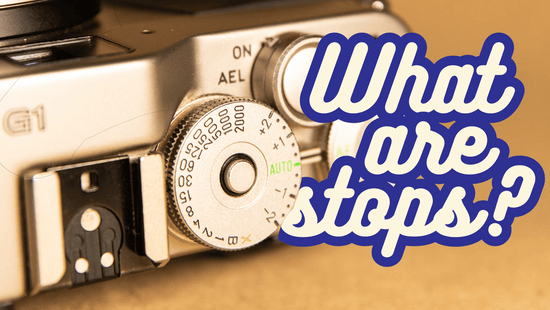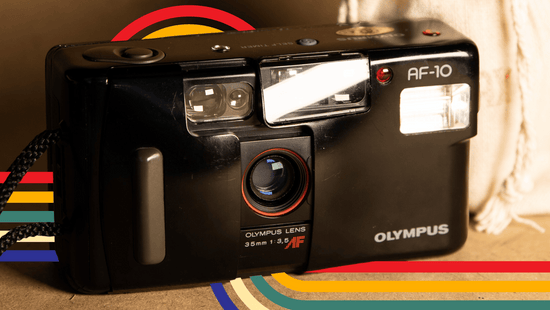Maybe you’ve got a blank roll of film back from the lab or maybe you felt like your roll of 35mm film rewound far too quickly for the amount of shots that you took. Well, in some cases, this can be due to not loading 35mm film correctly.
If you are certain you are loading 35mm film correctly and still received a blank roll, we recommend reading our post on diagnosing blank rolls of film here.
Otherwise, buckle up for a lesson on how to make sure your roll of film is loaded correctly every time and our tips for loading 35mm film.

Need to restock on 35mm film?
Whether you are using a SLR film camera or a point and shoot film camera, there are simple ways to make sure that you are loading 35mm film correctly every time.
Disclaimer: this is not a guide on how to load your film into each different type of 35mm film camera, but rather just helpful tips to make sure you aren’t missing photographs as a result of loading 35mm film incorrectly.
Loading 35mm film camera with automatic winding
35mm film cameras with automatic winding often have a small marker to show where your film should be positioned when loading the film into the camera. This marker indicates where the end of the film leader should be. The sprockets should also line up when positioning your film correctly here.

Loading 35mm film camera with manual winding
Loading 35mm film into a 35mm film camera with manual winding is the most commonly messed-up loading. When loading 35mm film into these cameras, the film leader should be tucked into one of the slots on the advancing film spool. This ensures that the film is latched properly onto the spool and that when you advance the film, the film will remain attached. You can fire one or two shots here to make sure that the film is properly wrapped about the spool.

Need some more help with double checking that you are loading 35mm film correctly? Keep reading!
Our Tips for Loading 35mm Film
Tip 1: Looking at your shot counter
Okay, this one only applies to point and shoot 35mm film cameras. Most point and shoot cameras, with automatic loading or a LCD display for the shot counter, will only display the number 1 when the film is loaded correctly.
You can test to see if your camera operates this way by firing a few shots with the back closed and no film inside. If your shot counter does not move past 1, then you know that your camera only starts counting shots when the film is loaded correctly in the back of the camera. If the shot counter does move past 1 when you know there is no film in the back of the camera, then this trick does not apply to you.

Tip 2: Looking at your rewind knob
This one applies to SLR cameras (and a few point and shoot cameras). These cameras have a rewind knob. This is the piece that you rotate when you are rewinding your roll of film. However, it also has a helpful function for when you are loading 35mm film and checking that your film is loaded correctly part-way through a roll of film.
After one or two shots have been taken, your rewind knob should begin to rotate as you advance your advance lever or winding wheel. Watch closely when you fire your next shot. When you advance the film to the next frame, the rewind knob will begin to turn at the same time.
If it does not start rotating, it is possible that your film is not loaded correctly as there is no connection between the advancing spool and the rewind knob where the roll of film is located underneath.

Tip 3: Opening the back of the camera
Woah, woah, woah. Everyone tells you not to open the back of your 35mm film camera when you have the film loaded, right? Yes, you are right. Opening the back of your camera once your film has been loaded and advanced will result in your images being light leaked.
However, if you are totally unsure whether the film is loaded correctly, you can open the back after a couple of shots to check. Be warned, you will lose the images you have already taken if you do this, but my logic is you’d rather lose two shots at the beginning of the roll of film than get to the end and realise that none of your memories and photographs have been recorded because the film was never loaded correctly.
When opening the back to see if the film is loaded correctly, you’ll be looking for the film to be wrapped all the way around the spool. You should see the film wrapped around the spool completely and the film you are about to use on top of this. See the image below for what we are talking about.
You can do this with any type of 35mm film camera. And it seems like a worthwhile sacrifice. Most rolls of 35mm film account for this anyway, so you will probably still end up getting the full amount of shots on your roll of 35mm film.

Tip 4: Don’t close the back just yet!
This applies to people with SLR 35mm film cameras! People are so quick to close the back of their camera when loading 35mm film and then play the world’s worst guessing game of “did I load that correctly?”
Instead of slamming the back shut as soon as you think you have got the film latched onto the spool correctly, take a moment to take a couple of shots and check that the film is correctly wrapped around the spool. Once you are confident, then you can close the back. At worst, you’ve lost maybe one frame of your roll of film. But this is nothing compared to losing an entire roll due to user error!


These are our tips for making sure that your 35mm film is loaded correctly in your camera every time. With practice, loading 35mm film gets easier and easier every time. Soon, you will be a loading 35mm film pro and get your film loaded correctly without even thinking about it.
If you like what we do, but can't buy a camera from us, please consider buying us a cup of coffee! It helps us to keep these resources free, consistent, and accessible.







